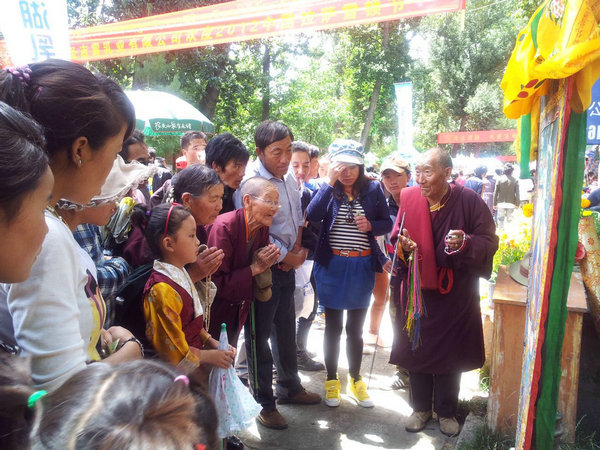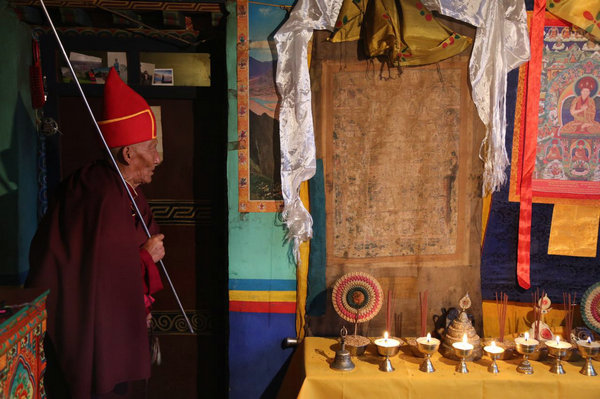
Trinley (right) performs at the Norbulingka Park in Lhasa during the Shoton Festival.[Photo provided to China Daily]
Trinley, 76, narrates Buddhist folktales depicted in the Thangka paintings using a wooden stick. Usually, it takes hours, but sometimes even days to finish a story. He is one of the few remaining performers of this ancient art.
In Barkhor Street, a bustling commercial center and popular tour site in Lhasa, capital of the Tibet autonomous region, where the symbolic Jokhang Temple is located, Trinley takes to the stage and attracts crowds with Lamamani, a traditional Tibetan performance which involves singing and storytelling.
Every day at around 9 am, the 76-year-old man arrives there and prepares to perform.
Wearing a long deep-red robe, yellow, a wide-brimmed hat and a pair of black leather boots, he first hangs a piece of Thangka painting on the wall and then announces the beginning of his performance by blowing a white conch-shell horn.
He tells Buddhist folktales depicted in the Thangka paintings using a wooden stick to point at the paintings. Usually, it takes hours and even days to finish one story.
Trinley is one of the few remaining performers of Lamamani, an ancient performing art.
Performed by Tibetan monks on streets, especially during holidays, Lamamani was included in the intangible cultural heritage list of Tibet in 2008 and Trinley was named the official inheritor of Lamamani, according to Ngawang Tenzin, deputy director of Tibet's intangible cultural heritage protection center.
To protect the dying tradition, the center started a project around four years ago, collecting images, documents, and video materials about Trinley's life, his experiences of learning Lamamani, performances and teaching of the art.
On Dec 14, the center announced the completion of the project.
The videos and transcripts will be digitized and stored in the database of the center.
At the same time, CDs recording Trinley's performances and a narration of the history of Lamamani have been published by the center.
Tenzin says that the center sent a team with Trinley to his home in a village of Lhozhag county, Shannan prefecture, located in southeast Tibet, early this year. This is where Trinley started learning and performing Lamamani.
They documented the journey and recorded his tour there.

Trinley's home in Lhozhag county, Shannan prefecture[Photo provided to China Daily]
According to Tenzin, Trinley's parents were Lamamani performers. In an interview with Tibet Daily last year, Trinley said that he learned the art form from childhood and he toured with his mother, performing Lamamani from the time he was 7. At 10, Trinley became a monk and studied Buddhism at a temple in his hometown. This helped him further his research and improve performance of Lamamani.
"I toured with my parents to perform Lamamani during the Shoton Festival (a traditional religious occasion, also known as the Yogurt Banquet Festival). We performed at many places during the weeklong celebration and then traveled back to our village," says Trinley.
"The performers, who were greatly respected, carried on the mission of spreading Tibetan culture."
The stories performed by Trinley are folktales portrayed on Thangka paintings, such as the one of Padma Obar, a half-man half-god figure, who takes the throne with his super powers; and Princess Wencheng, a princess of the Tang Dynasty (618-907), who traveled thousands of miles to marry Tibetan King Songtsan Gompo.
Trinley says Lamamani is similar to Ache Lhamo, or Tibetan folk opera, which dates back to the 14th century and is a combination of dancing, chanting and singing around Buddhist stories and Tibetan folklore.
But the history of Lamamani is longer than Ache Lhamo. Tenzin says that as Lamamani has few "inheritors" this is something that concerns Trinley very much.
"As performers have to make a living by touring and it usually takes years to master the techniques, few people, especially the younger generation, are willing to make such commitment," says Tenzin.
To keep the art alive, the center picked up four actors, two women and two men, aged between 20 and 50, from Lhasa Niangre Folk Art Troupe, to study with Trinley from May this year.
Migmar, the director of the Lhasa Niangre Folk Art Troupe, says: "The four actors are the best in our troupe and they have solid performance techniques.
"They mainly perform Ache Lhamo and other traditional Tibetan arts like singing and dancing for nomadic families in Tibet."
The troupe, which has about 50 actors now, was first founded in the 1960s.
"As of now, the four students have gained some basic knowledge about Lamamani. The training will be a long process since the art is an oral culture and very ancient. We hope more people will join in, and it would be great if our effort could rekindle the interest of the younger generation," says Migmar.





